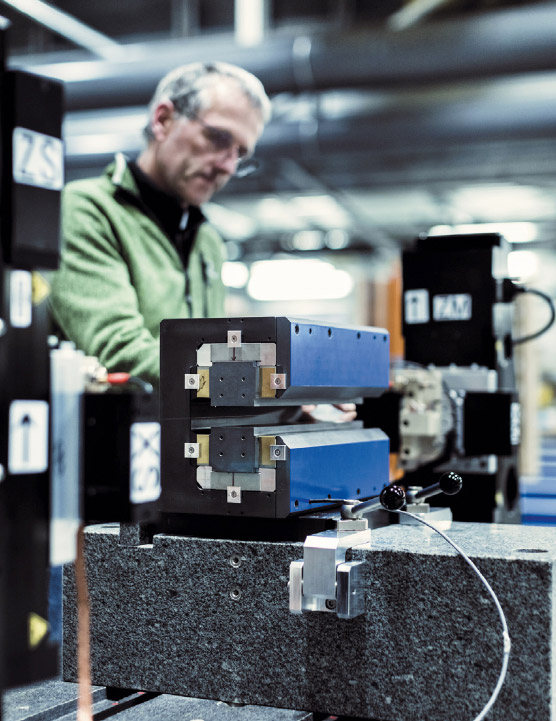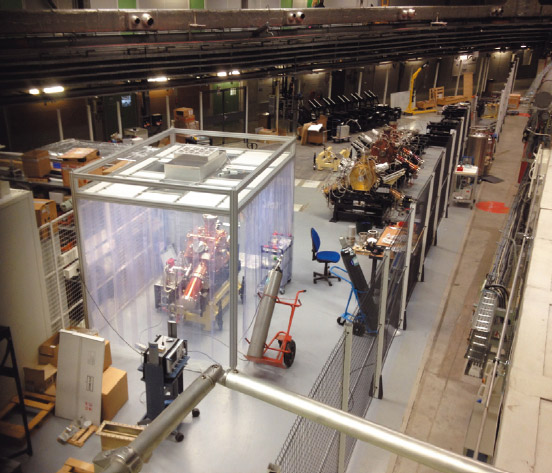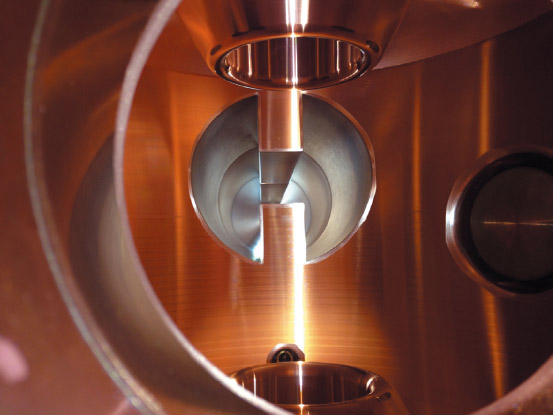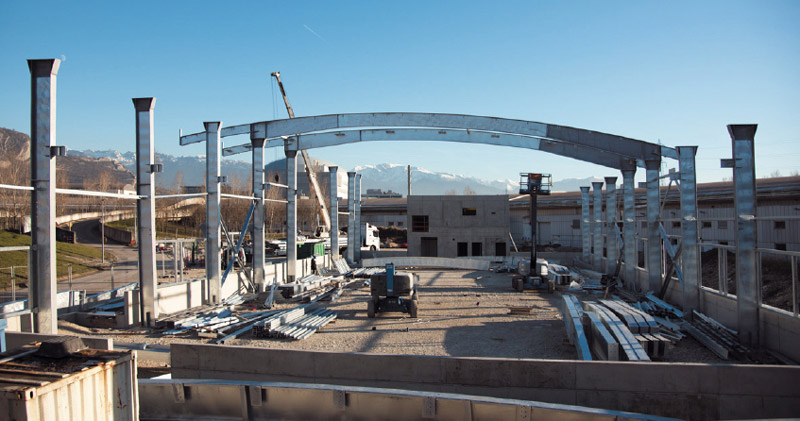- Home
- Users & Science
- Scientific Documentation
- ESRF Highlights
- ESRF Highlights 2016
- Status of the EBS
Status of the EBS
The past year marked the second year of the execution phase of the ESRF's Extremely Brilliant Source (EBS) project, which will see the implementation of a new lattice for the storage ring. This lattice will reduce the natural horizontal emittance from 4 nm to about 134 pm, thus greatly increasing the brilliance and coherence of the beam, opening up new horizons for accelerator science. Much of the work of the project in 2016 concentrated on finalising the design and following up on the procurement of the components. Numerous prototypes were tested, validated and launched into production and, in the second half of the year, the first pieces of equipment were already being delivered onsite. In addition to this, great effort went into the detailed planning and organisation of the assembly, dismantling and installation phases, complex work that defines the logistical requirements, task sequences and resource needs for the next four years. Finally, by the end of the year, the first new buildings to be constructed for the project started to go up – a visual and concrete reminder that the EBS project is very much taking shape!
Project management
Overseen by the Accelerator Project Office (APO), the work on the ESRF–EBS project was presented for review to the Machine Advisory Committee (MAC) on two occasions during 2016. In April, the EBS team informed the panel of accelerator experts that around 90% of the design work had been completed and all of the critical prototypes and tests had been successful, with about 60% of the planned calls for tender for equipment launched. The committee was very satisfied with the progress made and, in particular, commended the team for working on the possibility of providing users with a range of different X-ray sources (the lattice dipoles or additional short bending magnets, 2-pole wigglers or 3-pole wigglers) for ESRF and CRG bending magnet beamlines. Feedback from the Committee also included a suggestion to place four fully-assembled girders in a ‘mock-up’ tunnel and execute all the installation tasks foreseen, such as cabling, piping, vacuum connections and alignment, which will be put into practice in 2017.
The MAC met again in September and was pleased to note new developments including the assembly of a prototype dipole (Figure 1), thermal tests on the prototype girder and ground preparations for the new EBS buildings. Chairman Richard Walker said, “The project is on track and there have not been any changes to the major project milestones. The MAC therefore sees no showstoppers at this stage for the successful and timely realisation of the project.”
 |
|
Fig. 1: The members of the Machine Advisory Committee, together with ESRF colleagues, inspect the newly-delivered dipole magnets in the Chartreuse Hall. |
In addition to the MAC meetings, two EBS team events were held in July and December 2016 to discuss project strategy and focused largely on the assembly, dismantling and installation phases. Issues such as planning constraints, phase organisation and resource requirements were reviewed in detail and the most critical future actions to be taken were addressed.
Also during 2016, a series of open seminars was put in place to encourage collaboration between facilities and the sharing of experience of constructing low-emittance storage rings. Speakers including Pedro Tavares from Max IV, Michael Borland from APS, and Ferdinand Willeke from NSLS were invited to share their experience and discuss the challenges of all aspects of design, construction, installation, and commissioning of MBA-based storage rings. The seminars have been very well received by interested members of ESRF staff and are set to continue over the course of the project.
Procurement progress
Tremendous progress was made in 2016 on the procurement of the components for the new storage ring. By the end of the year, the largest calls for tenders were issued and 46 out of 47 contracts launched had been signed, while contracts were already in progress for the electromagnetic septa, RF gaskets, thermocouples and full metal isolation valves. The girder handling system is being finalised with a specialised company in charge of the contract.
Manufacturing of prototype or ‘pre-series’ components began, including vacuum chambers, photon absorbers and vacuum instrumentation such as RGA analysers, gauges, bellows and pumping ports. Concerning the magnets, the pre-series manufacturing is in progress for the moderate gradient quadrupoles, dipole-quadrupoles and octupoles. The pre-series high-gradient quadrupoles, sextupoles and correctors have already been built.
Following the successful validation of prototypes or ‘pre-series’ equipment, production of the ‘main series’ of components for the new machine also started. For the magnets, this included the sextupoles, high-gradient quadrupoles and correctors. For other components, this included the girders, dipole supports, RF cavities, RF fingers, DC-DC converters, beam loss monitors and vacuum pumps. All the beam position monitor buttons for the EBS have been manufactured and delivered – these were the first serial production items completed.
Delays to the project could be caused by manufacturing set-backs and so the procurement process will continue to be closely monitored – from the first design of a component until its delivery – over the course of the project.
Delivery of the first components
Marking a major milestone for the EBS, the first components started to arrive onsite during the second half of 2016.
The first girders for the new storage ring were delivered to the Chartreuse Hall at the end of October (Figure 2). These two supports, of 5 m-long and 6 tonnes, were the first of 130, the remainder to be delivered progressively in 2017. Four girders will be set up in the Chartreuse Hall and installed with real components as part of a ‘mock-up cell’ exercise, while the other 126 will be stored in the new building ESRF 02 until the assembly phase begins in October 2017.
 |
|
Fig. 2: The first EBS girder was delivered to the Chartreuse Hall in October 2016. |
As well as the girders, the first magnets also started to arrive in autumn 2016, the prototype dipole components at the end of August, and the first sextupoles at the end of November. The main series of dipole components followed soon after – with a total delivery of over 13,000 high-performance permanent magnets, 640 magnet modules and 128 dipole supports by the end of the year.
In-house assembly of dipoles started
Following the successful validation of a prototype and the subsequent delivery of the dipole components, the series production of the first EBS magnets began in December 2016.
The construction of a large series of dipoles needs to be carefully controlled to reach the required magnetic field quality and therefore the magnets are being assembled in-house (Figure 3), relying on the expertise and experience of our staff with permanent magnets. Each dipole is an assembly of around 100 samarium-cobalt permanent magnets, distributed between five magnet modules made of low-carbon steel with pure iron poles, bolted to a support.
 |
|
Fig. 3: Joel Chavanne takes magnetic measurements of one of the dipole magnet modules. |
Over the summer of 2016, a magnet assembly area was set up in the ESRF’s Chartreuse Hall. A prototype dipole, consisting of support, modules and magnets, was delivered at the end of August and assembly began in September. The modules were assembled with the magnets and measured before being mounted on the support and re-measured in order to test the strength of the magnetic fields. The exercise served to refine the assembly, measurement and calibration process, which will continue until December 2017, with over 60 tons of magnetic material to assemble over the course of the year.
RF cavity production makes good progress
Following the validation of three prototypes, the first of the 12 new HOM-damped single-cell radio frequency cavities arrived at the ESRF in June 2016. They will replace the existing five-cell cavities in the EBS storage ring. Three more were delivered later in the year, ready to be conditioned onsite by the RF team.
 |
|
Fig. 4: The dedicated RF assembly area in the ID08 zone of the experimental hall. |
The cavities, which were developed in-house, are being manufactured using complicated fabrication processes involving high temperature brazing. This, along with the careful assembly under clean room conditions at the ESRF (shown in Figure 4) resulted in a conditioning time of just two weeks per cavity – a very comfortable match for the EBS schedule. Following delivery to the dedicated assembly area, the cavities are equipped with their ancillary equipment, baked and RF conditioned, ready to be installed on the new ring in 2019. The internal geometry of the cavities has been carefully designed to maximise beam acceleration and at the same time to efficiently damp the higher order modes (HOM) by means of their attached HOM dampers. Figure 5 shows the first of the series of 12 cavities in fabrication.
 |
|
Fig. 5: Inside a HOM-damped single-cell radio frequency cavity. |
Electrical power
In 2016, the power requirements for the EBS project were finalised, allowing the launch of the procurement of more than 1000 power supplies to power the main magnets. Tests of the future power cabling were carried out on the prototype girder, resulting in the definition of the best cabling layout.
EBS construction work develops
A total of eight new buildings will be constructed in the centre of the storage ring over the course of the project to house the multitude of activities generated by the EBS.
The first of the new EBS buildings was completed in October 2016. Known as ESRF 10, the 200 m2 temporary building will be used to store spare accelerator equipment that is currently stockpiled in the technical zones surrounding the accelerator tunnel. The technical zones will be used in the coming months to store the newly-arrived girders so space was needed quickly and the temporary building was deemed the most practical option. The foundations were laid in September and the building went up in a matter of days.
Ground preparation for the main permanent buildings, ESRF 01 (see Figure 6) and ESRF 02, kicked off in August and continued through the autumn. The 1100 m2 surface of ESRF 01 will be used to assemble the girders for the new machine and then, once this is completed, it will serve as a workshop. ESRF 02A and ESRF 02B, two 500 m2 buildings, will be used to store newly delivered components before and during the assembly phase. Ground preparation also began for three temporary buildings, ESRF 11, 12 and 13, which will be used as workshops to perform radiation activation measurements on the components removed from the tunnel. An extension to the existing accelerator technical buildings (MTBS) is also planned for November 2018 to provide a new location for the RF test stand and additional space to store RF components.
 |
|
Fig. 6: The frame structure of the new assembly building ESRF 01 was put into place in December 2016. |
Beamline upgrade
2016 marked the start for the preparation of the upgrade of the beamlines in the ESRF’s portfolio. The upgrade includes the construction of four new beamlines as well as the preparation of the existing beamlines for the EBS.
Following a call for expressions of interest from the user community, launched in October 2015 and concluded in March 2016, the ESRF received 48 proposals. The proposals have been assessed by ESRF experts and grouped by scientific theme. The outcome of this analysis was discussed at the meeting of the Science Advisory Committee (SAC) in May 2016. This resulted in the selection of eight scientific themes to be served by upgraded beamlines and a shortlist of a number of major refurbishment projects to existing beamlines.
During the last three months of 2016, the ESRF started the preparation of Conceptual Design Reports (CDRs) for the potential new beamlines to be constructed within the EBS project. For each of the eight selected scientific themes, a working group (external experts, SAC observer, beamline scientists) has been mandated to develop a draft CDR condensing the scientific case into a potential beamline project, with the results as follows:
CDR1 – Beamline for coherence applications
CDR2 – Beamline for hard X-ray diffraction microscopy
CDR3 – High throughput large field phase-contrast tomography beamline
CDR4 – Surface science beamline
CDR5 – Advanced high-flux nano-X-ray diffraction beamline for science under extreme conditions
CDR6 – Facility for dynamic compression studies
CDR7 – High brilliance XAS beamline
CDR8 – Serial crystallography beamline
The draft CDRs were presented to the public in a two-day event called the EBS Science Workshop, held on 8-9 December 2016 at the ESRF, to solicit input from the user community at large for further refinement of the CDRs. The CDRs are now available in final form and will be further analysed by the SAC before they make a recommendation on the future beamline portfolio of the ESRF.
Instrumentation and data management
The EBS programme comprises an ambitious instrumentation and technology programme, which is required to gain the greatest benefit from the new source properties. This programme is centred on the following five themes:
1. New advanced metrology tools and methods for X-ray optics to cope with the challenging characteristics of the new optical components required to preserve the new source properties
2. The development of a double-crystal monochromator for spectroscopy with unprecedented characteristics
3. Generic end station design, using mechatronic concepts and on-line metrology for performance enhancement in terms of stability, accuracy, speed, automation and user-friendliness
4. A robust detector development plan, mandatory for optimum exploitation of the new source properties
5. An ambitious modernisation programme on beamline control and new data analysis platforms including innovative solutions to manage and process large volumes of data
While there was progress on all five themes, emphasis was put on the online data reduction and analysis. First versions of the library of common software routines for analysing data from synchrotron sources (code name SILX) have been released in the past months (https://github.com/silx-kit). Furthermore, the implementation of the ESRF Data Policy has started. The systematic recording of metadata is under test at ID01, ID11, ID31, and the MX beamlines, progressing at a rate of ten beamlines per year, as part of the plans to complete the implementation of the ESRF data policy by 2020. Hand in hand with the work on the beamlines, the IT infrastructure is being upgraded to increase the bandwidth and capacity of the storage and to allow for the long-term archival of the data from the beamlines. Additional compute nodes have been procured and made available to process the rapidly increasing data volume produced by the beamlines.
R. Dimper, M. Krisch, P. Raimondi, H. Reichert, J. Susini and A.J. Joly



